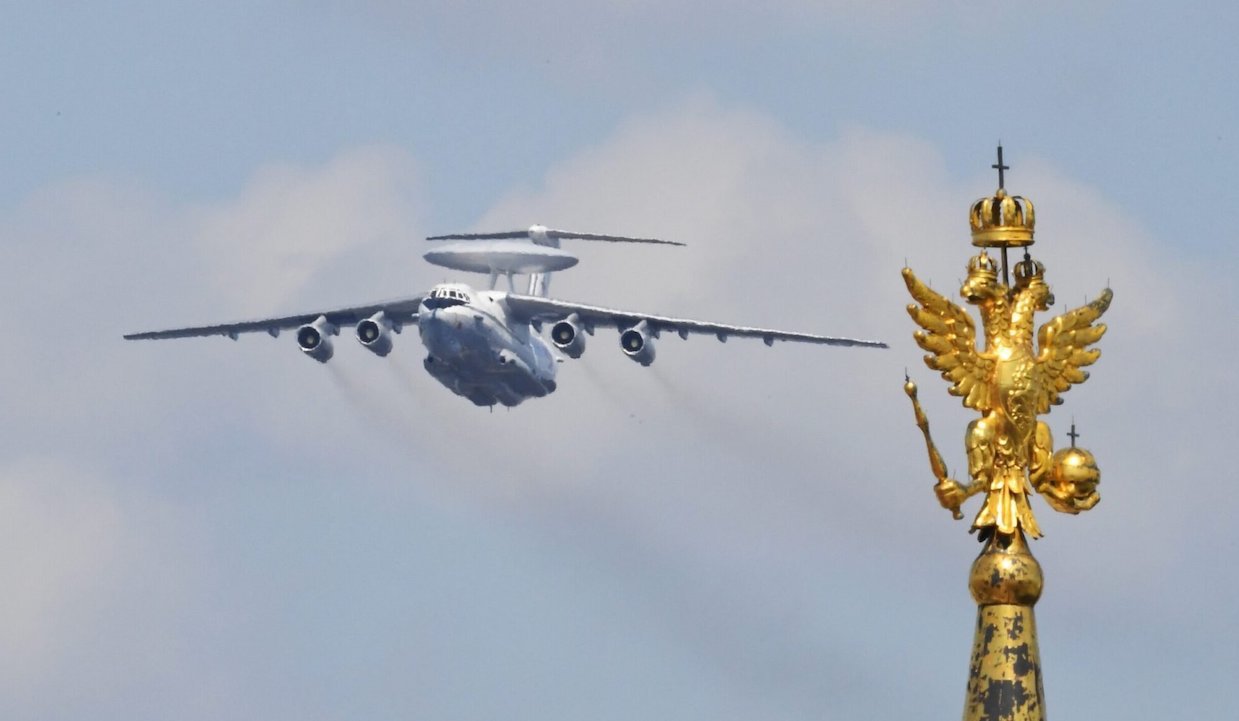Mysterious Attack to Strategic Russian Spy Plane A-50 in Belarus. Ukraine Intelligence and CIA may Plotted it without Kiev Permission

A Russian Aerospace Forces (VKS) Beriev A-50U during the lates Victory Day in Moscow which is very strategic in Ukrainian war because it serves as the targeting platform for the Kh-47M2 Kinzhal hypersonic missile.
Originally published by Russia Today
All links to Gospa News articles have been added aftermath in relation to the topics highlighted
The US believes that elements of Ukraine’s intelligence service carried out a cross-border attack on a Russian spy plane in Belarus without approval from the Ukrainian government, Breaking Points journalist Saagar Enjeti reported on Monday, citing leaked documents.
The attack saw a drone inflict minor damage to a Russian A-50 early warning and control aircraft stationed at the Machulishchy air base in Belarus last month. Belarusian authorities arrested a number of suspects, one allegedly linked to the Ukrainian secret police organization, the SBU, which Belarusian President Alexander Lukashenko accused of orchestrating the attack with help from the CIA.
Ukraine Denied Involvement on Attack to A-50 Spy Plane
The Ukrainian Foreign Ministry “categorically” denied any involvement by Kiev, while Ukrainian presidential adviser Mikhail Podoliak blamed the attack solely on “local partisans.”
The Pentagon, however, assessed that the SBU carried out the attack without seeking the approval of President Vladimir Zelensky or his officials, Enjeti said in a video report on Tuesday. The alleged Pentagon documents containing the assessment were leaked on social media last week, and have since received considerable media attention.
CIA’s Ground Branch is Training Ukrainian Paramilitaries against Russia.
The report on the plane attack raises the question of “how much control does Zelensky actually have” over his own intelligence apparatus, Enjeti said. “Perhaps this lends credence to the idea that there are a bunch of rogue elements inside the [Ukrainian] government that are basically doing whatever they want,” he continued, citing a string of terrorist attacks within Russia as potential SBU operations.
Zelensky Losing Control of Intelligence agents
The Kremlin has repeatedly blamed Ukraine and its intelligence services for these attacks, which include the bombing of the Crimean Bridge and the assassinations of journalist Daria Dugina and military blogger Vladlen Tatarsky.“Whenever Ukraine does something, who is doing it?”
Enjeti asked. “Zelensky presents himself as the leader … but obviously there are elements of the government there that don’t listen to him. Who knows what they’re going to drag us into.”
The US Department of Defense has not confirmed the authenticity of the leaked documents, although a department spokesman told reporters on Monday that the files posted on social media were “similar in format” to those used in Pentagon briefings and intelligence updates. The leak presents “a very serious risk” to Washington, he added.
Other files in the leak detail the US’ war plans in Ukraine, its surveillance of its allies, Kiev’s rapidly depleting ammunition situation, and other “sensitive” material related to Ukraine, China, the Middle East, and terrorism.
Originally published by Russia Today
Why drones targeted a Russian A-50U, vital for hypersonic Kinzhal strikes
Warning. Gospa News has decided to republish this article in its entirety due to the interesting military technical analysis contained in it.Furthermore, Gospa News does not necessarily share all the information and opinions expressed in it as it was written on a site very close to the Pentagon and NATO which can therefore provide an altered view of the real perception of the critical issues of the war in Ukraine. All links to Gospa News articles have been added aftermath in relation to the topics highlighted
by Reuben Johnson – originally published on Breaking Defense
On Feb. 26, multiple news outlets reported that two explosions occurred on the Machulishchy aerodrome of the Belarus armed forces — apparently the result of drone strikes, later claimed by an opposition guerrilla group known as the Association of Security Forces of Belarus or BYPOL.
The target of these explosive suicide drones was a Russian Aerospace Forces (VKS) Beriev A-50U (NATO Codename Mainstay) airborne early warning (AEW) and battle management platform. The aircraft is similar in function to the Boeing E-3 Sentry AWACS models operated by the US Air Force and several allied nations.
But unlike the AWACS, the A-50U’s main mission in the skies around Ukraine is less to do with battle management and more to do with aiding a key weapon in Russia’s arsenal: serving as the targeting platform for the Kh-47M2 Kinzhal hypersonic missile.
A-50U’s SATCOM radome in support of MiG-31K
The Kinzhal is usually launched from a special variant of the Mikoyan MiG-31, designated the MiG-31K. The aircraft has been extensively modified by having all of the on-board systems replaced with a new set of hardware that transforms the aircraft from an air-to-air homeland defense interceptor into a launch platform for the Kinzhal.
Instead of the MiG-31K carrying the normal complement of Vympel R-37/RVV-BD long-range air-to-air missiles, the aircraft instead is fitted with one Kinzhal that is mounted centerline. The key to being able to have an operational set of coordinates for this missile is the A-50U’s SATCOM radome, which acts as the primary targeting asset for the MiG-31K.
The threat posed by the combination of these two platforms is perhaps the most indefensible weapon system facing Ukraine.
Earlier in the year a NATO-nation defense attaché on temporary assignment in Kyiv reported to Breaking Defense that “whenever the A-50 is detected as airborne the air raid sirens sound in the city. No matter where you are you head for an air raid shelter — and this can be four times or more per day.”
Kinzhal Missile to strike at high-value Targets
The attaché later explained that Ukraine Intelligence had determined that anytime the A-50 was aloft it was accompanied by two or more MiG-31Ks and that there was no telling when or if these aircraft might launch on demand or if these were just training flights.
The forte of the Kinzhal is to strike at high-value targets, “like command centres or major military installations,” he explained. Even more of a concern is that the Kinzhal is essentially an air-launched version of the KBM Iskander ballistic missile and achieves hypersonic speeds. Ukraine’s current crop of anti-missile defense systems are useless against this class of weapon.
“This is what makes the combination of the MiG-31K and the A-50 an existential threat every time they are in the air,” said the attaché.
As Russia continues its campaign of indiscriminate missile attacks on civilian targets, the inability of Russian industry to produce replacements has seen the number of available air-launched cruise missiles depleted. Estimates from open-source researchers put stocks of the Raduga Kh-101/Kh-555 at only 15 percent of the pre-war inventory, and only 9 percent of the Novator Kalibr missile stock. However, those same estimates indicate as much as 85 percent of the Kinzhal missiles are still unused and available.
Of the 84 missiles that were fired by Russia against Ukraine on March 9 — one of the largest missile attacks of the war — only 6 were Kinzhals. Despite the small quantity this was the largest number of this missile type fired in one day thus far.
“This will make any of the A-50s — regardless of where they are based – increasingly a first-order target for either partisan activity or for the increasing capability of the PSU’s fleet of strike drones,” said a representative from a Ukrainian defence industrial firm that has been at the forefront of developing capabilities to hit targets behind Russian lines. “We have no way of taking down a Kinzhal once they are launched, so this may be the best way of making sure they are minimally effective against us.”
Partisan Attacks Within Belarus Increasing
Like its US analogue, the aircraft is a heavily modified variant of a large transport platform, in this case the Ilyushin IL-76. The configuration changes include outfitting the IL-76 with a large radome in the aircraft’s nose section and an approximately 30 feet in diameter rotating SATCOM antenna array mounted on top of the fuselage.
Manufacturer-released data on the antenna arrays advertise it as being able to detect airborne targets within 400 miles and surface targets within 190 miles. At ranges slightly greater than 200 miles the onboard radar operators processing the data from these radar sensors can manage up to 150 targets simultaneously.
The problem for Russia’s military is that the A-50U models are available only in small numbers – somewhere between six and nine types of this version actually exist. There are additional reports that that majority of these have not been seen in operation for some time. This leads to speculation that most of these aircraft are not combat-capable due to a lack of component spare parts — perhaps another consequence of sanctions prohibiting the import of western electronics imposed on Russia since February 2022.
https://www.gospanews.net/en/2023/04/10/top-fake-why-the-leaked-natos-secret-plan-for-a-ukrainian-military-offensive-doesnt-add-up-rt-warning/
Not surprisingly, the attack on the A-50U seemed to have focused on the two sensor and radar tracking sections that are the heart of the A-50U’s airborne battle management mission were the primary targets of the attack on the aircraft. Actual footage of the strike itself on the aircraft has not been seen, but video shot from what have been assessed to be two commercially-acquired drones show these vehicles alighting on the two radar modules of the aircraft more than once — and in the process demonstrating the ease with which this platform could be sabotaged.
Representatives who were claiming to speak on behalf of BYPOL told media outlets that this video was shot during a period of “two weeks [when] Belarusian partisans conducted aerial reconnaissance at Machulishchy military airfield with the help of civilian drones purchased in a store.”
The uploaded videos, which were credited to the Ukraine Air Force (PSU), are accompanied by a chart detailing the internal arrangement of the A-50 and the functions assigned to the workstations in the crew sections inside the fuselage. The aircraft in question (registration number RF-50608 43 R) is one of the more advanced A-50U versions, in which some of the original on-board systems have been replaced with lighter-weight and superior signal-processing capacity digital hardware.
The damage to the A-50U was not enough to permanently disable the aircraft
The damage to the A-50U was not enough to permanently disable the aircraft, likely due to the inability of the commercially acquired drones used in the attack to carry more than small payloads of explosives. Late in the same day of these drone strikes a Russian Air Force Il-76 (RF-86843) and a An-26 military transport aircraft both arrived at the Machulishchy aerodrome carrying spare parts in order to affect repairs on-site instead of immediately dispatching the A-50 to a full-service overhaul depot.
Several days later, on March 2, the aircraft was then flown out of Belarus and arrived at the VKS 325th Aviation Repair Plant in Taganrog for a more extensive re-fit and replacement of any of the more seriously damaged on-board components.
The attack on this aircraft has implications for how the war in Ukraine is being prosecuted today, as well as how Russia will continue to deploy its most valuable air force assets in Belarus.
Previously, Belarus had been considered safe harbor for Russia to base its forces and position military hardware, but a poll late last year finds found that 90 percent of the population is against their country becoming involved in the war. The consequence is that acts of sabotage by Belarus partisans against Putin’s military, which began almost immediately after the February 2022 invasion, have become more frequent and the BYPOL movement of saboteurs is gathering more followers.
In a recent interview, a former Belarus serviceman who would only identify himself as “Anton” told the Associated Press “Belarusians will not allow the Russians to freely use our territory for the war with Ukraine, and we want to force them to leave. The Russians must understand on whose side the Belarusians are actually fighting.”
One of the leaders of the BYPOL underground, Aliaksandr Azarau, who is based outside of the country, told the AP that the attack on the Russian A-50 was “an attempt to blind Russian military aviation in Belarus” and to free the country “from the Russian occupation” as well as from [Aleksandr] Lukashenko’s regime.
“We have a two-headed enemy these days,” said Azarau, in reference to the Russian military occupation and Lukashenko’s regime.
Given the increase in partisan activity, Russia may have to reposition some of its assets to more secure locations – in the same way that the VKS have removed much its bomber fleet in Russia to bases out of range of Ukrainian strike drones.
Lukashenko: “Security Service of Ukraine (SBU) and CIA Operations against the Republic of Belarus”
Lukashenko, the Belarusian leader, did not initially acknowledge that the attack had occurred, waiting until more than a week later on March 7 to offer any comment.
“The plane did not suffer any significant damage […],” he was quoted on the site Aviation Safety Network that catalogues all aircraft-related mishaps worldwide. “Nevertheless, we asked the Russians to take the plane for maintenance and send us another one.”
Dugina Assassination: Russian FSB Identified the Suspect Ukrainian BombMaker (video)
The use of the word “us” was somewhat revealing, as it appeared the Belarus president is now lumping in his country with Russia as an active ally and participant in this war. Up to this point Lukashenko has maintained a bare façade of neutrality in the conflict, but he has nonetheless given Russian air forces access to bases and other facilities in his nation. Russia has also enjoyed unrestricted use of Belarus airspace for conducting repetitive air and missile strikes against Ukraine.
Russian ground forces had also been deployed inside his borders since before the war. In the initial phases of the February 2022 invasion, Belarus served as a launching pad for a massive ground force that was planned to move south into Ukraine and take Kyiv. (This part of the invasion force failed after multiple breakdowns of its motorized transport and armor units brought the 35-mile convoy to a halt.)
Part of Lukashenko’s delayed reaction may have to do with his domestic opponents not only embarrassing him by taking credit for putting this A-50U aircraft out of action, but also their use of the incident to claim a victory against his dictatorship. Until their publicized claims of responsibility he had attempted to pretend that the attack had never taken place.
The most prevalent of these came from a spokesman for Sviatlana Tsikhanouskaya, the figurehead leader of the Belarus opposition-in-exile in Lithuania, who called this drone strike “the most successful act of sabotage [against Lukashenko’s regime] since the beginning of 2022.”
Despite initial claims by BYPOL that the organizers of the attack had escaped across the border to Ukraine before the smoke drone strikes had even cleared, Belarus security forces have since arrested more than 20 individuals. They are all accused of working with Ukrainian and US intelligence services in planning the attack on the A-50.
“The Security Service of Ukraine, the leadership of the CIA, behind closed doors, are carrying out an operation against the Republic of Belarus,” Lukashenko was quoted as saying. “A terrorist was trained” by these foreign intelligence agencies, he continued in reference to one of those in custody, who is a dual Russian-Ukrainian national.
by Reuben Johnson – originally published on Breaking Defense
MAIN SOURCES
“ISIS Fighters Recruited by US Special Service for Terrorist Attacks”. Russian Intelligence Warning
Nord Stream Sabotage: Moscow blames Washington for “this Unprecedented Act of Terrorism”



